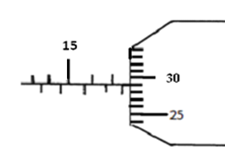Instructions to candidates
- This paper consists of two sections A and B.
- Answer all the questions in the two sections
- All working must be clearly shown.
- Electronic calculators and Mathematical tables may be used.
- All numerical answers should be expressed in the decimal notations.
- The diagram below shows a micrometer screw gauge. What is the reading in SI units? (2 marks)
- The figure below shows apparatus used to observe behavior of smoke particles in a smoke cell.
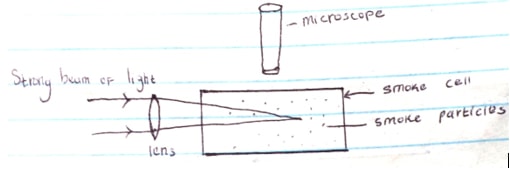
- State a reason why smoke particles are used in the experiment. (1mk)
- State the observation made. (1mk)
- What would happen if temperature was lowered? (1mk)
- Explain why fish can survive under water when the surface is already frozen. (1mk)
- State one way on which the stability of the can be increased. (1mk)
- A stone is thrown horizontally from a building that is 50m high above a horizontal ground. The stone hits the ground at a point, which is 65m from the foot of the building. Calculate the initial horizontal velocity of the stone. (g=10ms-2) (3mks)
- The figure below shows air flowing through a pipe of non-uniform cross-sectional area .Two pipes A and B are dipped into liquids as shown below.
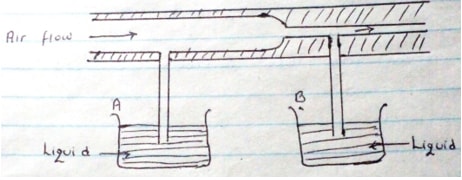
- Indicate the levels of the liquids in pipe A and B. (1mk)
- Explain your answer in (a) above. (1mk)
- When a mercury thermometer is used to measure the temperature of hot water, it is observed that the mercury level first drops before beginning to rise. Explain (2mks)
- Figure below shows a u-tube manometer containing a liquid L. One end connectected to a gas tap.
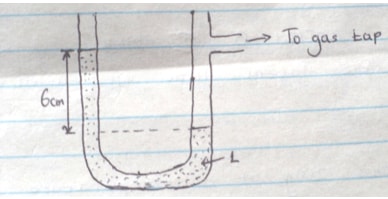
Given that the atmosphere pressure is 1.0×105pa, determinate the pressure of the gas (density of liquid L is 900kg/m3, g=10N/kg) (2mks) - A faulty thermometer reads 2oC when dipped in ice at 0oC and 95oC when dipped in steam at 100oC. What would this thermometer read if placed in water at room temperature at 18oC? (3 marks)
- Explain why a glass container with thick glass walls is more likely to crack than one with a thin wall when a very hot liquid is poured into it. (2mks)
- Find the amount of work in stretching a sprig constant 25 N/m when its lenghth is increased from 0.1m to 0.2m. (3mks)
SECTION B (55MARKS)
-
- Define specific latent heat of fusion of a substance. (1mk)
- Water of mass 200g at a temperature of 600c is put in a well lagged copper calorimeter of mass of 80g. A piece of ice at 00 c and mass 20g is placed in the calorimeter and the mixture stirred gently until all the ice melts. The final temperatures, T of the mixture are then measured. Determine:
- The heat absorbed by melting ice at 00 (2mk)
- The heat absorbed by melted ice (water) to rise to temperature. T (Give the answer in terms of T (2mks
- The heat lost by warm water and the calorimeter. (2mks) (Give the answer interms of T)
- The heat lost by warm and the calorimeter (2mks) (Give the interms of T)
- The final temperature T of the mixture. (Specific latent heat of fusion of ice=334,000 Jkg-specific heat of water =4200Jkg-1, specific heat capacity of copper =900Jkg-1k-) (3mks)
- A ball bearing x is dropped vertically downwards from the edge of the table and it takes 0.5s to hit the floor below. Another ball bearing Y leaves the odge of the table horizontally with a velocity of 5ms-1 find :
- The horizontal distance travelled by Y before hitting the floor. (2mks)
- The vertical distance of the table top above the floor level. (2mks)
- A bullet mass of 22g travelling horizontal with a velocity of 300ms-1 strikes a block of wood of mass 1978g which rests on a rough horizontal surface. After impact the bullet and the block move together and come to rest when the block has travelled a distance of 5M. Calculate :
- The velocity of bullet and wood after impact. (2mk)
- The force of friction between wood and surface. (2mks)
- A car starts from rest and accelerates uniformly at 2m/s2 for 5 seconds before accelerating again at 2.5 m/s2 for 2 more seconds. The car is then brought to rest in another 2 seconds.
- Sketch a velocity time graph for this motion. (2mks)
- From the graph, calculate the total distance travelled. (2mks)
-
- State two important factors to be considered when selecting the banking angles of a road.
- A ball of mass 2kg is whirled at the end of a string in a horizontal circular path at a speed of 5m/s-1. If the string is 2.0m long find,
- Angular velocity of the stone? (3mks
- The tension of the string.
- The figure below shows a block of mass 30.0kg being pulled up a slope by a force F at a constant speed. The friction force on the block is 200 N.
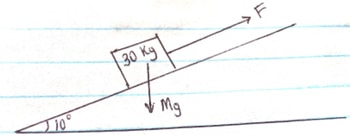
-
- On the same figure above name and indicate the other forces acting on the block. (2mks)
- Determine the force acting on the block down the slopes. (2mks)
- Determine the value of F (2mks)
- On reaching the top of the slopes. The block is left to run freely down the slopes.
- Which of the force previously acting on the block would then act in the opposite direction? (1mk)
- Determine the acceleration of the block down the slope. (2mks)
- What is the effect of increasing the angle of the slopes on your answer in (ii) above? (1mk)
-
-
-
- State Newton’s second law of motion. (1mk)
- The figure below shows a sphere moving in a viscous liquid in a tall measuring cylinder.
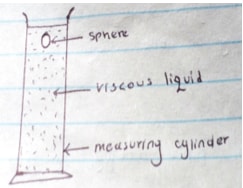
Show on the diagram the force acting on the sphere. (3mks) - Sketch on the Cartesian plane below a graph of the variation of velocity with time until the ball attains terminal velocity.
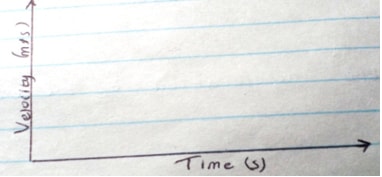
-
- State Boyle’s law. (1mk)
- What is the absolute zero temperature? (1mk)
- A bicycle pump with the exit hole closed contains 80cm of air at 760 mmHg pressure and a temperature of 10c. When the air was compressed to 38cm under a pressure of 1700mmHg pressure, its temperature rises. Calculate the rise in temperature. (2mks)
-

MARKING SCHEME
-
Sleeve scale = 17.50mm
Total reading = 17.50 + 0.29
Thimble scale = 29 X 0.01 = 0.29mm
= 17.79mm
= 1.779 X 10-2 m
-
- Smoke particles are lighter than air particles and big enough to be seen.
- The smoke particles are observed to be in continuous random motion.
- The rate of continuous motion reduces due to decrease in k.e.
- Water at 4oc is denser; it is also poor conductor of heat.
- - Increase base area
- Lower C.O.G - H=½gt2
-
-

- The liquid level is high in pipe B than in pipe A because is low deu to the high speed of the air.
-
- - The bulb gets heated first and expands creating more volume.
- The mercury then gets heated and expands. - Gas pressure=pa +hpg
=1.0×105+ (900×10×0.06)
=10, 000+540
=100,540 pa -
0------ 100 →100 units
Reading = 2 + 16.74
2 ------ 95 →93 units
= 18.74 o C
1 unit = 93/100 = 0.93 units
18 units = 18 X 0.93
= 16.74 - For a thick glass, the inner wall expands more than the outer wall because glass is a poor conductor, while in a thinner one, the expansion is uniform.
- W=½ke2
=½ ×25× (0.1)2
=½ ×25× 0.01
=0.125J
SECTION B
-
- Specific latent heat of fusion a substance required to melt completely one kilogram of a substance to liquid without change in temperature.
-
- Q=ML
=0.02×334,000J
=6680J - Q=Mcd0
=0.02×4200 (t-0)
=84T J - Heat lost by warm water
=mcDo
=0.2×4200 (60-T)
Heat lost by colollmeter
=mcDo
=0.08 ×900 (600T) - Heat gained=Heat lost
6680+84T=0.2 ×4200 (60-T) +0.08×900 (60-T)
6680 +84T =50,400 + 4320 -72T
996T =48040
T= 48.2oC
- Q=ML
-
- R=ut =5×0.5
=2.5ms-1 - S=ut+½gt2
u=0
S= ½×10× (0.5)2
= 5×0.25
= 1.25m -
- m1u1+m2u2= (m1+m2) v
(0.022×300) = (0.022 +1.978) v
6.6=2v
V=3.3ms-1
- m1u1+m2u2= (m1+m2) v
-
-
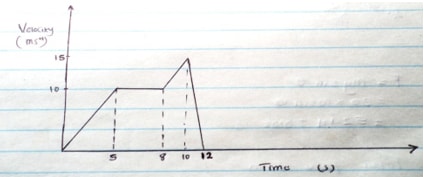
- ½×5×10=25
3×10=30
(15+10)×½×2=50
½×2×15=15
25+30+50+15=120m
-
- R=ut =5×0.5
-
- Radius of the curve.
Critical speed. -
- W=v/r
=5/2
=2.5rads-1 - T=Fc=mv2
r
= 2×52
2
= 0.625 = 0.3125N
2
= 0.3125N
- W=v/r
- Radius of the curve.
-
-
-
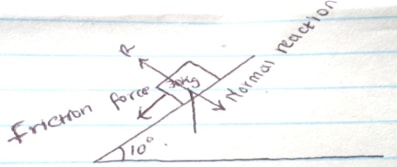
- F=mgsinθ
=30×10sin10
=52.1N ±0.02 - F=Total force down
=mg sin 0 +friction force
=52.1N + 20.0N
=72.1N
-
-
- Friction force
- Net force down =mg sin –friction force
=52.1 -20
=32.1
But F=ma
A=f/m=32.1=1.07ms-2
30 - Acceleration downwards increases with increase in angle
-
-
-
- The rate of change of momentum of the body is directly proportional to the applied force and takes place in the direction of force.
-
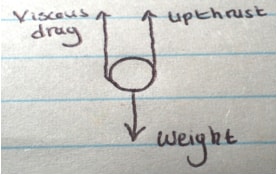
-

-
- For a fixed mass of a gas pressure is inversely proportional to the volume at constant temperature.
- Temperature at which the gas molecules have zero internal energy.
- P1V1=P2V2
T2 T2
760×80 =1700×38
283 T2
T2=1700×38×283
760×80
=300.68
Temp rise =300.68-283 =17.69k
17.69k
-
Download PHYSICS PAPER 1 - 2019 KCSE TAP TRIAL MOCK EXAMS (QUESTIONS AND ANSWERS).
Tap Here to Download for 50/-
Get on WhatsApp for 50/-
Why download?
- ✔ To read offline at any time.
- ✔ To Print at your convenience
- ✔ Share Easily with Friends / Students

